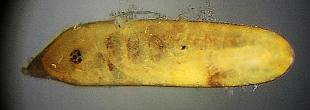
The egg of Calopterygidae
A final renewal day is September 24, 2003.

They are five species of Calopterygidae which inhabit Kinki area. The size of these eggs and a form often look alike. A difference in individual of the size seems to be comparatively big.
How to obtaining eggs : It doesn't lay eggs easily in the filter paper and so on. The female which lays eggs is found. Then, the plant that it lays eggs is collected.@
It is living until it hatches even if an egg isn't taken out when it lays eggs in the water plant (in such cases as Egeria densa) and moss. However, an egg is taken out when it lays eggs in the fallen leaves and so on. If it doesn't do like that, the embryonic development of the egg sometimes stops. It is good to send air to the egg of the species which inhabits running water.1. Calopteryx japonica Selys@
Size: Right after laying; head diameter; 1.22mm, a short
diameter 0.20mm. Just before hatching; head diameter 1.31mm, a short
diameter; 0.27mm. Duration of egg : The shortest duration; 11days. Average duration;
15days. It lays eggs with Calopteryx japonica in the stem such as Hydrilla
verticillata and Egeria densa in the running water.
@
Figure4-1: After laying, the 9th day
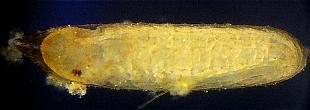
@
2. Calopteryx atrata Selys
Size: Right after laying; head diameter; 1.22mm, a short diameter 0.21mm. Just before hatching; head diameter 1.30mm, a short diameter; 0.27mm. Duration of egg :The shortest duration; 13days. Average duration; 15days. It lays eggs with Calopteryx atrata in the stem such as Hydrilla verticillataCEgeria densa and Potamogeton malaianus to grow in the slow flow.
Figure4-2: After laying, the 11th day
@
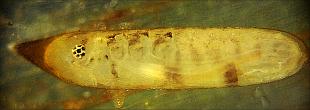
@
3. Calopteryx cornelia Selys
Size: Right after laying; head diameter; 1.23mm, a short diameter 0.25mm. Just before hatching; head diameter 1.36mm, a short diameter; 0.33mm. Duration of egg : The shortest duration; 13days. Average duration; 16days. It lays eggs with Calopteryx atrata in the stem such as Hydrilla verticillataCEgeria densa and Potamogeton malaianus to grow in the slow flow. It is good when it is put in the environment which is the same when the driftwood which laid eggs is collected.@ Driftwood is only soaked in water, and embryonic development of the egg sometimes stops.@ The driftwood which laid eggs is put in the water tank, and embryonic development is done smoothly when air is sent with an air pump. The egg which was taken out from the driftwood and which was put under water hatched smoothly, too.
Figure4-3: After laying, the 13th day
@
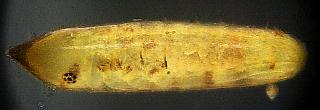
@
4. Mnais pruinosa Selys
Size: Right after laying; head diameter; 1.20mm, a short diameter 0.21mm. Just before hatching; head diameter 1.26mm, a short diameter; 0.27mm. Duration of egg : The shortest duration; 14days. Average duration; 17days. It seems to lay often eggs in moss to grow in the mountain stream, and the little driftwood.
Figure4-4: After laying, the 11th day
@
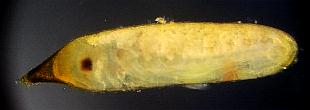
@
5. Mnais costalis Selys
Size: Right after laying; head diameter; 1.22mm, a short diameter 0.21mm. Just before hatching; head diameter 1.30mm, a short diameter; 0.27mm. Duration of egg : The shortest duration; 10days. Average duration; 11days. It seems to lay often eggs in the stem of a plant to grow in the slow flow, the leaf which died, and so on.
Figure4-5: After laying, the 15th day
@
